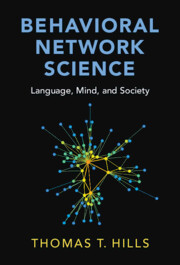Book contents
- Frontmatter
- Contents
- Additional Resources
- Introduction: Structure Matters
- Part I A Brief Guide to Network Science
- Part II Language
- 4 Zipf’s Law of Meaning: The Degree Distribution of the Mind
- 5 Network Learning: Growing a Lexicon by Degrees
- 6 What Is Distinctive: Exploring Edge Types in Multilayer Networks
- 7 The Small-World Spectrum: Using Small Worlds to Compare Networks
- 8 The Birthplace of New Words: Identifying Node Origins
- 9 Agent-Based Models of Language Emergence: Structure Favors the Orangutan
- Part III Mind
- Part IV Society
- References
- Index
7 - The Small-World Spectrum: Using Small Worlds to Compare Networks
from Part II - Language
Published online by Cambridge University Press: 08 November 2024
- Frontmatter
- Contents
- Additional Resources
- Introduction: Structure Matters
- Part I A Brief Guide to Network Science
- Part II Language
- 4 Zipf’s Law of Meaning: The Degree Distribution of the Mind
- 5 Network Learning: Growing a Lexicon by Degrees
- 6 What Is Distinctive: Exploring Edge Types in Multilayer Networks
- 7 The Small-World Spectrum: Using Small Worlds to Compare Networks
- 8 The Birthplace of New Words: Identifying Node Origins
- 9 Agent-Based Models of Language Emergence: Structure Favors the Orangutan
- Part III Mind
- Part IV Society
- References
- Index
Summary
Some people appear to learn more slowly. Could they just be learning different things? Suppose two groups of children are learning words – they have growing vocabularies – but one group acquires the list more slowly than the other. Can we use the structure of the information they learn to gain insight into whether or not they are learning different information? Small worlds are one way of measuring the structure of a community. When quantitatively defined, small worlds have a number of useful properties, including that they compare the structure of a network relative to different versions of itself, thereby providing a kind of ‘control’ network against which to benchmark a measurement. In this chapter, I discuss small worlds and several ways to evaluate them, and then use them to answer a simple question: Are children who learn to talk late just slow versions of early talkers? Or are they learning something different about the world? Along the way, I will enumerate three different approaches to explaining where structure comes from: function, formation, and emulation.
Keywords
Information
- Type
- Chapter
- Information
- Behavioral Network ScienceLanguage, Mind, and Society, pp. 101 - 115Publisher: Cambridge University PressPrint publication year: 2024
